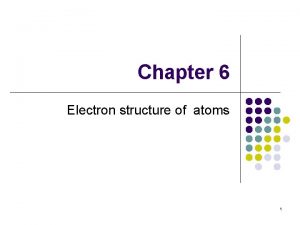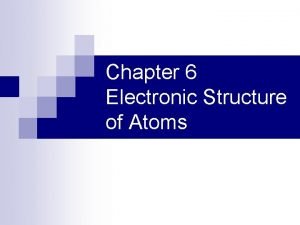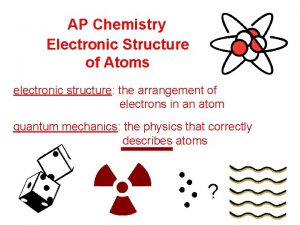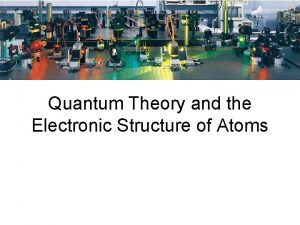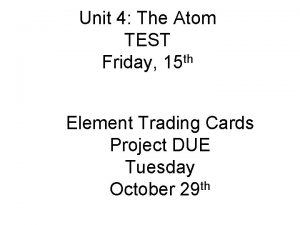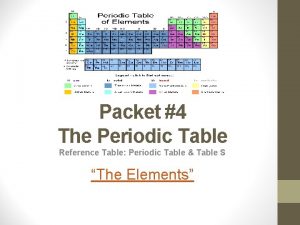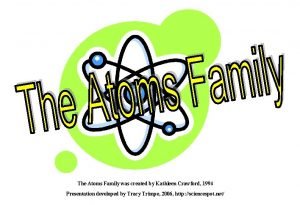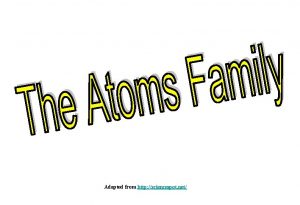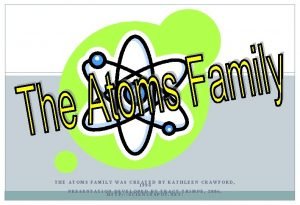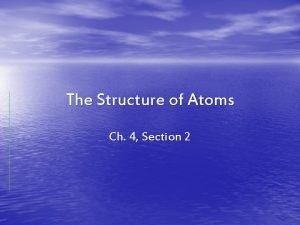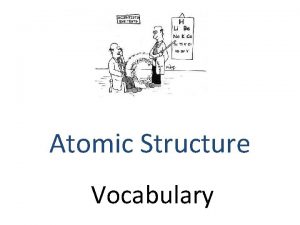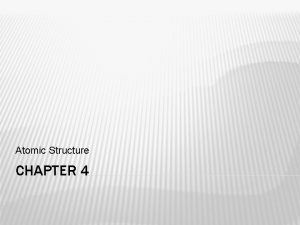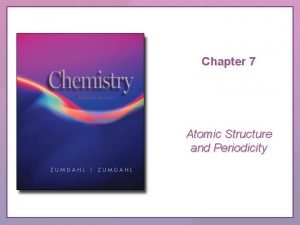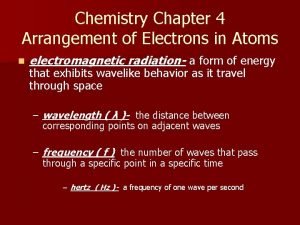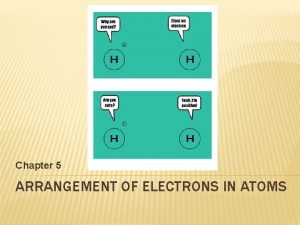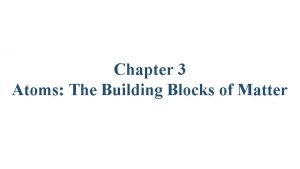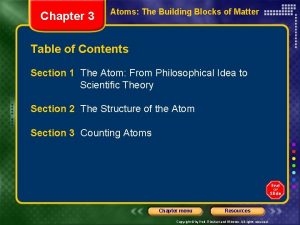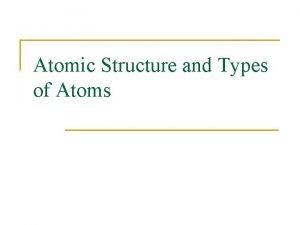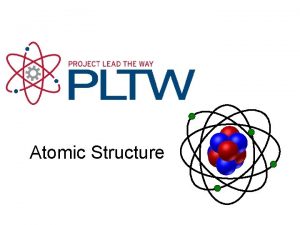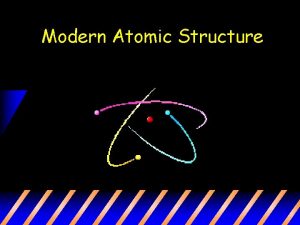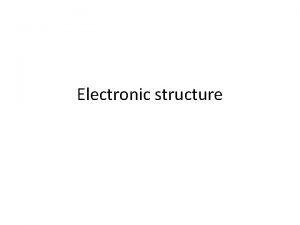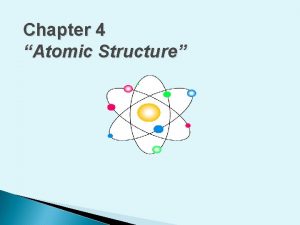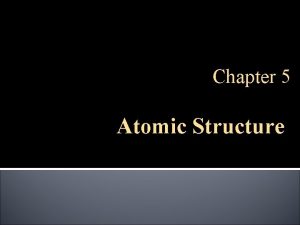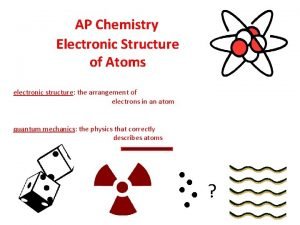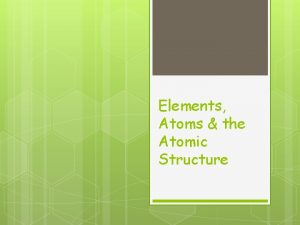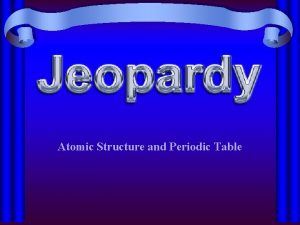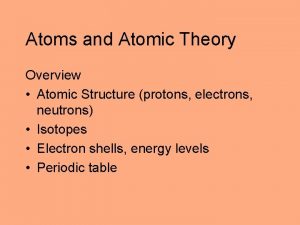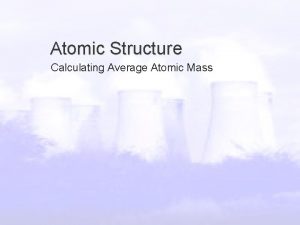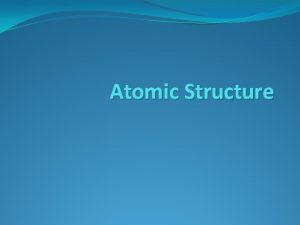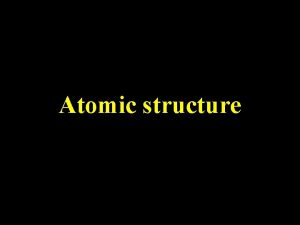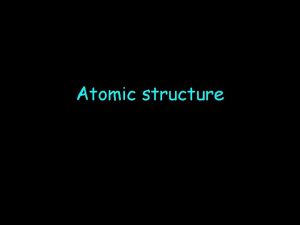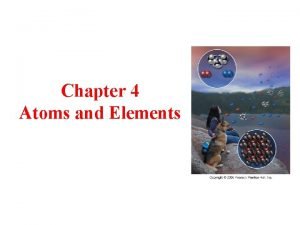Chapter 4 Atomic Structure Electronic Structure of Atoms

























![Electron Configuration ØNa: 1 s 2 2 p 6 3 s 1 ØNa: [Ne] Electron Configuration ØNa: 1 s 2 2 p 6 3 s 1 ØNa: [Ne]](https://slidetodoc.com/presentation_image_h2/990b305e8c6e508ddbe79da756c2f9d4/image-26.jpg)






- Slides: 32

Chapter 4 Atomic Structure Electronic Structure of Atoms

The Wave Nature of Light: Wavelength and Frequency Light travels through space as a wave, which is made up of a successive crests. Electronic Structure of Atoms

Wavelength (λ): is the distance between two consecutive crests or troughs. λ should be expressed in (m) Frequency (ν): is the number of wave cycles that pass a given point in unit time. ν should be expressed in (Hz). λν =c where c, the speed of light, is a constant, 2. 998 × 10 8 m/s Electronic Structure of Atoms

The Nature of Energy • Einstein used this assumption to explain the photoelectric effect. • Light is considered as a stream of particles called photons, whose energy E is given by Einstein equation. • He concluded that energy is proportional to frequency: E = h where h is Planck’s constant, 6. 63 10− 34 J-s (i. e. units for h are J • s) Electronic Structure of Atoms

The Nature of Energy • Therefore, if one knows the wavelength of light, one can calculate the energy in one photon, or packet, of that light: c = E = h Electronic Structure of Atoms

Example • The green light associated with the aurora is emitted by excited oxygen atom at 557. 7 × 10_9 m. What is the frequency of this light and calculate the energy of a photon emitted by an excited oxygen atom. ν =c/λ = 2. 998 × 108 m/s 557. 7 × 10 _9 m = 5. 376 × 10 14 /s E = hc / λ (6. 626 × 10 -34 J. s) (2. 998 × 108 m / s) = = 3. 652 × 10 -19 557. 7 10 -9 m Electronic Structure of Atoms

The Nature of Energy • One does not observe a continuous spectrum, as one gets from a white light source. • Only a line spectrum of discrete wavelengths is observed. Electronic Structure of Atoms

The Nature of Energy • Niels Bohr adopted Planck’s assumption and explained these phenomena in this way: 1. Electrons in an atom can only occupy certain orbits (corresponding to certain energies). Electronic Structure of Atoms

The Nature of Energy • Niels Bohr adopted Planck’s assumption and explained these phenomena in this way: 2. Electrons in permitted orbits have specific, “allowed” energies; these energies will not be radiated from the atom. Electronic Structure of Atoms

The Nature of Energy • Niels Bohr adopted Planck’s assumption and explained these phenomena in this way: 3. Energy is only absorbed or emitted in such a way as to move an electron from one “allowed” energy state to another; the energy is defined by E = h Electronic Structure of Atoms

The Wave Nature of Matter • Louis de Broglie posited that if light can have material properties, matter should exhibit wave properties. • He demonstrated that the relationship between mass and wavelength was h = mv Electronic Structure of Atoms

Quantum Mechanics • Erwin Schrödinger developed a mathematical treatment into which both the wave and particle nature of matter could be incorporated. • It is known as quantum mechanics. Electronic Structure of Atoms

The Quantum Mechanical Model • Energy is quantized - It comes in chunks. • A quantum is the amount of energy needed to move from one energy level to another. • Since the energy of an atom is never “in between” there must be a quantum leap in energy. Electronic Structure of Atoms

Quantum Numbers • Solving the wave equation gives a set of wave functions, or orbitals, and their corresponding energies. • Each orbital describes a spatial distribution of electron density. • An orbital is described by a set of three quantum numbers. Electronic Structure of Atoms

Principal Quantum Number, n • The principal quantum number, n, describes the energy level on which the orbital resides. • The values of n are integers ≥ 0. Electronic Structure of Atoms

Azimuthal Quantum Number, l • This quantum number defines the shape of the orbital. • Allowed values of l are integers ranging from 0 to n − 1. • We use letter designations to communicate the different values of l and, therefore, the shapes and types of orbitals. Electronic Structure of Atoms

Azimuthal Quantum Number, l ℓ = (n – 1) Value of l 0 1 2 3 Type of orbital s p d f Electronic Structure of Atoms

Magnetic Quantum Number, m l • Describes the three-dimensional orientation of the orbital. mℓ = (2 ℓ + 1) • Values are integers ranging from -l to l: −l ≤ ml ≤ l. • Therefore, on any given energy level, there can be up to 1 s orbital, 3 p orbitals, 5 d orbitals, 7 f orbitals, etc. Electronic Structure of Atoms

Magnetic Quantum Number, m l • Orbitals with the same value of n form a shell. • Different orbital types within a shell are subshells. Electronic Structure of Atoms

Allowed Sets of Quantum Numbers for Electrons in Atoms Level n Sublevel 1 l 0 0 Orbital ml Spin ms 2 0 0 1 3 1 0 -1 0 0 1 1 0 -1 2 0 -1 -2 = +1/2 = -1/2 Electronic Structure of Atoms

s Orbitals • Value of l = 0. • Spherical in shape. • Radius of sphere increases with increasing value of n. Electronic Structure of Atoms

p Orbitals • Value of l = 1. • Dumbbell in shape • Have two lobes with a node between them. Electronic Structure of Atoms

d Orbitals • Value of l is 2. • Four of the five orbitals have 4 lobes; the other resembles a p orbital with a doughnut around the center. Electronic Structure of Atoms

Energies of Orbitals • For a one-electron hydrogen atom, orbitals on the same energy level have the same energy. • That is, they are degenerate. Electronic Structure of Atoms

Energies of Orbitals • As the number of electrons increases, though, so does the repulsion between them. • Therefore, in manyelectron atoms, orbitals on the same energy level are no longer degenerate. Electronic Structure of Atoms
![Electron Configuration ØNa 1 s 2 2 p 6 3 s 1 ØNa Ne Electron Configuration ØNa: 1 s 2 2 p 6 3 s 1 ØNa: [Ne]](https://slidetodoc.com/presentation_image_h2/990b305e8c6e508ddbe79da756c2f9d4/image-26.jpg)
Electron Configuration ØNa: 1 s 2 2 p 6 3 s 1 ØNa: [Ne] 3 s 1 Electronic Structure of Atoms

Electron Configurations • Electron configurations tells us in which orbitals the electrons for an element are located. • Three rules: Ø electrons fill orbitals starting with lowest n and moving upwards; Ø no two electrons can fill one orbital with the same spin (Pauli); Ø for degenerate orbitals, electrons fill each orbital singly before any orbital gets a second electron (Hund’s rule). Electronic Structure of Atoms

Writing Electron Configurations • First, determine how many electrons are in the atom. Iron has 26 electrons. • Arrange the energy sublevels according to increasing energy: – 1 s 2 s 2 p 3 s 3 p 4 s 3 d … • Fill each sublevel with electrons until you have used all the electrons in the atom: – Fe: 1 s 2 2 p 6 3 s 2 3 p 6 4 s 2 3 d 6 • The sum of the superscripts equals the atomic Electronic number of iron (26) Structure of Atoms

Electron Configurations and the Periodic Table • The periodic table can be used as a guide for electron configurations. • The period number is the value of n. • Groups 1 A and 2 A have the s-orbital filled. • Groups 3 A - 8 A have the p-orbital filled. • Groups 3 B - 2 B have the d-orbital filled. • The lanthanides and actinides have the f-orbital filled. Electronic Structure of Atoms

Hund’s Rule “For degenerate orbitals, the lowest energy is attained when the number of electrons with the same spin is maximized. ” Electronic Structure of Atoms

Periodic Table • We fill orbitals in increasing order of energy. • Different blocks on the periodic table, then correspond to different types of orbitals. Electronic Structure of Atoms

ELECTRON SPIN • 1920 --chemists realized that since electrons interact with a magnetic field, there must be one more concept to explain the behavior of electrons in atoms. • ms--the 4 th quantum number; accounts for the reaction of electrons in a magnetic field MAGNETISM • magnetite--Fe 3 O 4, natural magnetic oxide of iron • 1600 --William Gilbert concluded the earth is also a large spherical magnet with magnetic south at the north pole (Santa's habitat). • NEVER FORGET: opposites attract & likes repel PARAMAGNETISM AND UNPAIRED ELECTRONS • diamagnetic--not magnetic [magnetism dies]; in fact they are slightly repelled. All electrons are PAIRED. • paramagnetic--attracted to a magnetic field; lose their magnetism when removed from the magnetic field; HAS ONE OR MORE UNPAIRED ELECTRONS Electronic Structure of Atoms
 Chapter 6 electronic structure of atoms answers
Chapter 6 electronic structure of atoms answers Energy quanta
Energy quanta Ap chemistry electronic structure of atoms
Ap chemistry electronic structure of atoms Quantum theory and the electronic structure of atoms
Quantum theory and the electronic structure of atoms Periodic table regents
Periodic table regents The atoms family atomic math challenge answer key
The atoms family atomic math challenge answer key Periodic table refrence table
Periodic table refrence table The atoms family song
The atoms family song Perky patty proton
Perky patty proton The atoms family worksheet
The atoms family worksheet The atoms family atomic math challenge
The atoms family atomic math challenge Relative atomic mass of beryllium
Relative atomic mass of beryllium Period trends
Period trends Atomic trends
Atomic trends Mass of oxygen
Mass of oxygen Differentiate between atomic number and mass number
Differentiate between atomic number and mass number Atomic number vs atomic radius
Atomic number vs atomic radius Scrip exchange
Scrip exchange Electronic field production
Electronic field production Chapter 4 section 2 the structure of atoms answer key
Chapter 4 section 2 the structure of atoms answer key Chapter 4 atomic structure vocabulary
Chapter 4 atomic structure vocabulary Atomic structure
Atomic structure Ap chemistry chapter 7 atomic structure and periodicity
Ap chemistry chapter 7 atomic structure and periodicity Chapter 7 atomic structure and periodicity
Chapter 7 atomic structure and periodicity Chapter 4 arrangement of electrons in atoms test
Chapter 4 arrangement of electrons in atoms test Chapter 6 section 1 atoms elements and compounds
Chapter 6 section 1 atoms elements and compounds Ccechs
Ccechs Chapter 5 arrangement of electrons
Chapter 5 arrangement of electrons Chapter 6 section 1 atoms elements and compounds
Chapter 6 section 1 atoms elements and compounds Chapter 3 atoms the building blocks of matter
Chapter 3 atoms the building blocks of matter Which subatomic particle has the least mass
Which subatomic particle has the least mass Chapter 2 atoms molecules and ions
Chapter 2 atoms molecules and ions Atomic structure and properties ap chemistry
Atomic structure and properties ap chemistry
